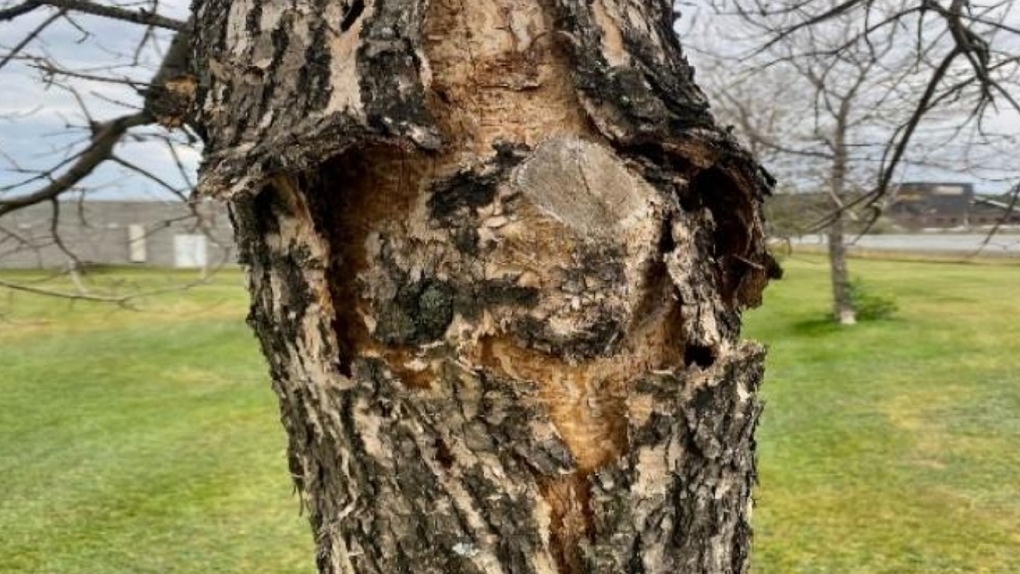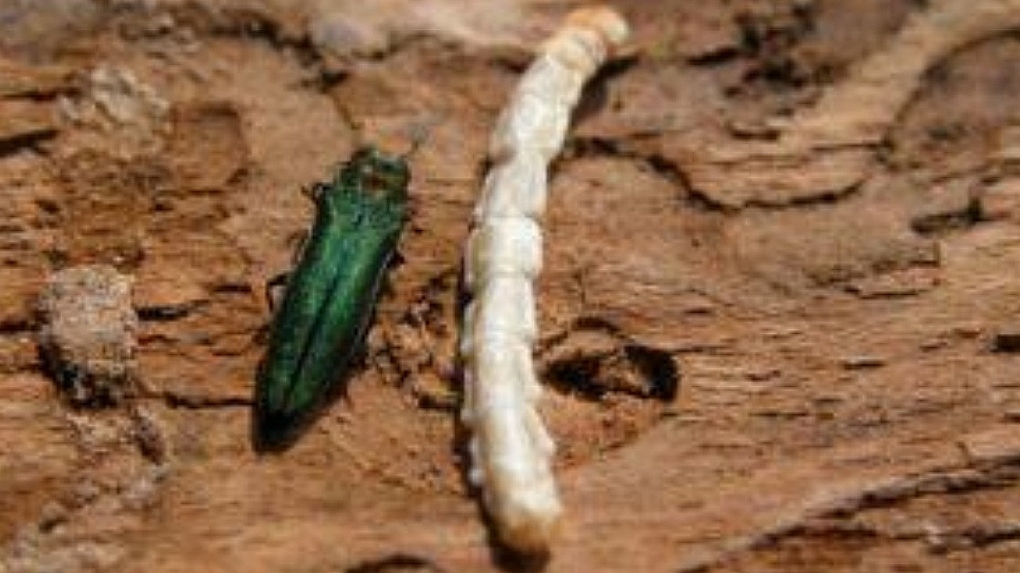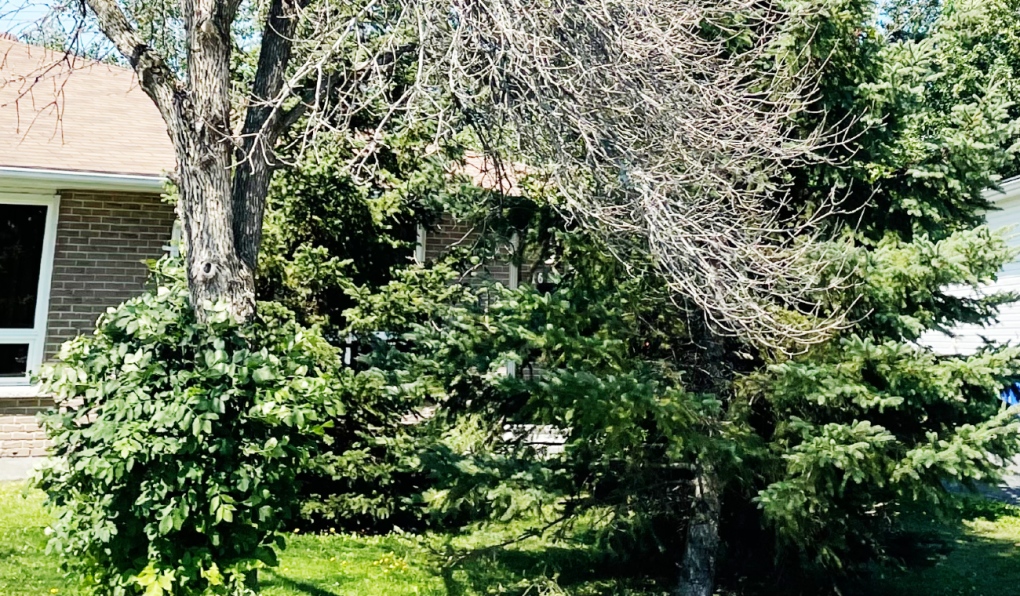Sudbury outlines $1.75M plan to remove diseased ash trees from city land
Greater Sudbury is planning to remove all 1,500 ash trees on municipal property because of a widespread infestation of a beetle – the emerald ash borer – that infects and kills the trees.
"Ash trees used to be a tree species that were suitable for urban planting in Greater Sudbury," said a staff report headed to the operation committee Oct. 15.
 An ash tree trunk destroyed by infestation by the emerald ash borer is seen in this undated photo. (City of Greater Sudbury photo)
An ash tree trunk destroyed by infestation by the emerald ash borer is seen in this undated photo. (City of Greater Sudbury photo)
"They contributed to a healthy urban canopy, were integral to air quality, ecological health of soil and watersheds and were resistant to road maintenance activities (e.g. salt and sand application)."
However, since it was first detected in 2002 in Windsor, Ont., the invasive beetle has steadily been moving north, destroying ash trees everywhere it turns up.
"Up to 99 per cent of ash trees within a specific location are killed by EAB (emerald ash borer) within 8-10 years of its establishment," the staff report said.
"EAB affects and eventually kills all ash species, including green ash and white ash that occur frequently in Greater Sudbury as street trees, in parks and private properties and in rural areas."
Another type of ash tree – black ash – is now endangered because of the invasive beetle.
 Since it was first detected in 2002 in Windsor, Ont., the invasive emerald ash borer has steadily been moving north, destroying ash trees everywhere it turns up. (City of Greater Sudbury photo)
Since it was first detected in 2002 in Windsor, Ont., the invasive emerald ash borer has steadily been moving north, destroying ash trees everywhere it turns up. (City of Greater Sudbury photo)
The dead and dying trees become a particular hazard during extreme weather, the staff report said, because they are easily uprooted.
"This was evident during the 2018 and 2021 microbursts and several ice storms that caused hundreds of trees, many of them Ash trees, to fall and cause significant damage in the community," the report said.
Since 2022, about 250 ash trees have been removed in the community, with another 1,000 remaining. There are another 500 dead or diseased trees in city parks, cemeteries and Sudbury Housing properties that need to be removed.
While the original plan was to remove all the trees by 2027, the EAB has progressed much faster than expected and the removal and replanting process must be accelerated.
 These trees in the New Sudbury area have been infected by the emerald ash borer. Affected trees will often have green shoots sprouting from the trunk because nutrients can no longer reach higher on the tree. (Darren MacDonald/CTV News)
These trees in the New Sudbury area have been infected by the emerald ash borer. Affected trees will often have green shoots sprouting from the trunk because nutrients can no longer reach higher on the tree. (Darren MacDonald/CTV News)
The city has applied for a grant for the tree removal and replanting project from the Federation of Canadian Municipalities Growing Canada’s Community Canopies, which offers to pay 50 per cent of the costs up to a maximum of $10 million.
The grant seeks funding to remove 1,500 diseased ash trees, at a cost of $1.2 million, and replace them with 18 different species of new trees, at a cost of $550,000.
The city aims to use contractors to complete the removal of ash trees on city property by the end of this year, with stump removal possibly extending into 2025. About 1,500 new trees will be planted at a rate of 400-450 trees each spring.
- Download the CTV News app now
- Get local breaking news alerts
- Daily newsletter with the top local stories emailed to your inbox
While the city will remove trees on its property, homeowners are responsible for trees on their property.
"Property owners are responsible for Ash trees on their private property, which includes maintenance, treatment and removal as deemed necessary," the report said.
"Staff will implement an extensive public communication strategy that will include providing information to residents about the project. It will provide information to residents on how they can manage their own private trees that are in decline and how they can assist with growing the city’s urban canopy."
If approved, the work will be funded by the existing tree removal operating budget, offset by the grant, if the application is successful.
Read the full report here. The operations committee will vote on the plan at its meeting Oct. 15.
CTVNews.ca Top Stories

opinion Tom Mulcair: Prime Minister Justin Trudeau's train wreck of a final act
In his latest column for CTVNews.ca, former NDP leader and political analyst Tom Mulcair puts a spotlight on the 'spectacular failure' of Prime Minister Justin Trudeau's final act on the political stage.
B.C. mayor gets calls from across Canada about 'crazy' plan to recruit doctors
A British Columbia community's "out-of-the-box" plan to ease its family doctor shortage by hiring physicians as city employees is sparking interest from across Canada, says Colwood Mayor Doug Kobayashi.
'There’s no support': Domestic abuse survivor shares difficulties leaving her relationship
An Edmonton woman who tried to flee an abusive relationship ended up back where she started in part due to a lack of shelter space.
opinion King Charles' Christmas: Who's in and who's out this year?
Christmas 2024 is set to be a Christmas like no other for the Royal Family, says royal commentator Afua Hagan. King Charles III has initiated the most important and significant transformation of royal Christmas celebrations in decades.
Baseball Hall of Famer Rickey Henderson dead at 65, reports say
Rickey Henderson, a Baseball Hall of Famer and Major League Baseball’s all-time stolen bases leader, is dead at 65, according to multiple reports.
Arizona third-grader saves choking friend
An Arizona third-grader is being recognized by his local fire department after saving a friend from choking.
Germans mourn the 5 killed and 200 injured in the apparent attack on a Christmas market
Germans on Saturday mourned the victims of an apparent attack in which authorities say a doctor drove into a busy outdoor Christmas market, killing five people, injuring 200 others and shaking the public’s sense of security at what would otherwise be a time of joy.
Blake Lively accuses 'It Ends With Us' director Justin Baldoni of harassment and smear campaign
Blake Lively has accused her 'It Ends With Us' director and co-star Justin Baldoni of sexual harassment on the set of the movie and a subsequent effort to “destroy' her reputation in a legal complaint.
Oysters distributed in B.C., Alberta, Ontario recalled for norovirus contamination
The Canadian Food Inspection Agency has issued a recall due to possible norovirus contamination of certain oysters distributed in British Columbia, Alberta and Ontario.

































